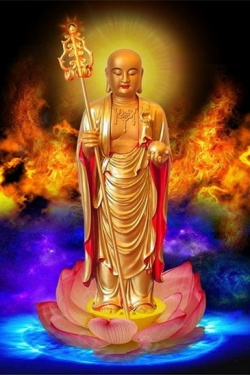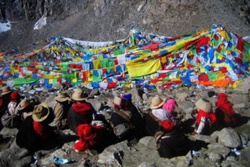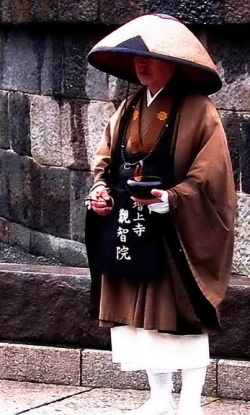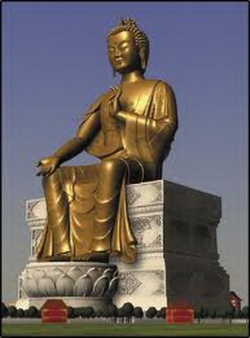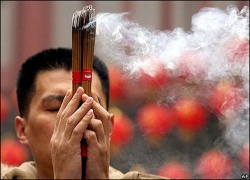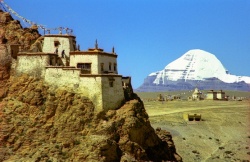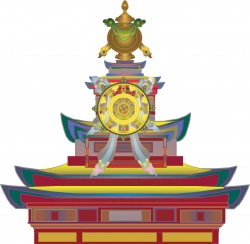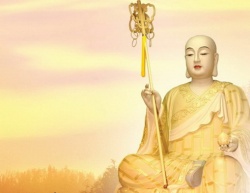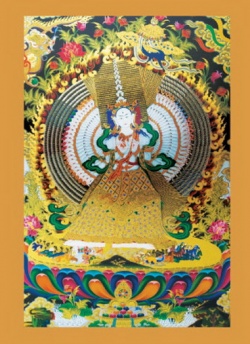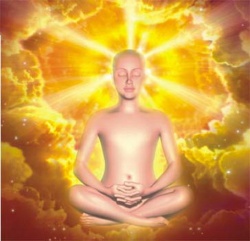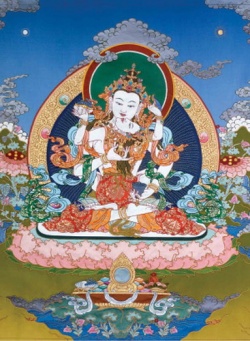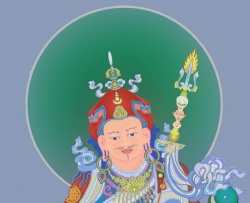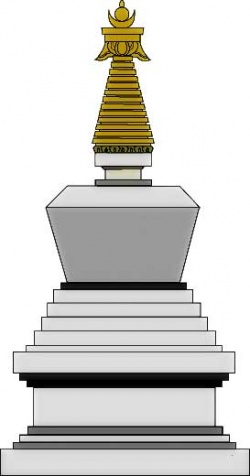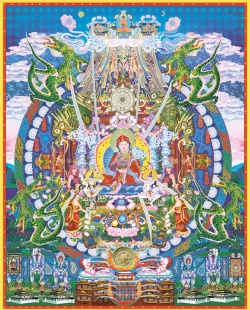Saving Time A Buddhist Perspective on the End By David R. Loy
May 1999
Each culture believes that every other space and time is an approximation to or perversion of the real space and time in which it lives. (Lewis Mumford)
What is the "real space and time" in which our culture lives? A hundred years ago it would have been easier to say, but the twentieth century has complicated things. In its early years relativity theory displaced the Newtonian paradigm of space and time as empty formal containers. At the other end of the century, postmodernism has shattered our linear future-orientation: the self's modernist alienation has given way to a fragmentation which releases our subjectivity from the intentionalities that used to focus it, encouraging a more fluid and multiple sense of personal and social identity.
This collapse of linearity would seem to imply the timelessness of simultaneity, but that has not meant freedom from time: in fact, time -- or the lack of it -- has become more of a problem for most of us. The dissolution of linear temporality is linked with accelerated ephemerality and a widespread increase in insecurity and anxiety, contributing a "manic" quality to much of public and private life. A "time-compression" effect means we experience ourselves as having less time to do the things we need or want to do. A 1992 survey found that 38 percent of Americans report "always" feeling rushed, up from 22 percent in 1971. Lou Harris polls have shown a 37 percent decrease in Americans' leisure time over a twenty year period, leading him to assert that "Time may have become the most precious commodity in the land. " But what if commodifying time is itself the problem?
Some see the comparison as nostalgia for a more leisurely past that never was. While Juliet Schor and A. R. Hochschild have argued that Americans are working much longer hours, some other academics, most notably John Robinson and Geoffrey Godbey, have responded by claiming that Americans have much more leisure time today than in the 1960s, with the notable exception of those who have graduate education (which may be an important exception, given the background of those most likely to read and write papers such as this one). Then do we actually have less time, or does it only feel that way, because there is something different about the way we "use" time today? I am in no position to adjudicate the debate, yet it serves to remind us that temporality is one of those social constructions which, once objectified, returns the compliment by objectifying us. For that reason, however, we need to consider not only economic and technological factors (e.g., instantaneous communications) but also ideological ones that address how and why we construct time the way we do, especially the role such constructions play in our larger world-view of what the world is and where we are going within it.
In The Condition of Postmodernity
David Harvey presents a sophisticated Marxist understanding of the problem. Recognizing that there is no single, objective sense of time or space, Harvey emphasizes that neither can be assigned meaning independent of material processes: their apparent objectivity is due in each case to the material practices that reproduce them, and they are never socially neutral, usually being the focus of struggle. Marx himself had little to say about how clock-time has transformed people's subjectivities, but his later works examined how capitalist accumulation is based upon "the annihilation of space by time." Harvey continues this analysis by understanding our present experience of time-space compression as one of a series generated by the logic of capital accumulation and its tendency toward vertical integration to circulate market commodities more speedily.
Time's arrow may fly only in one direction, yet reductionism is a game that can be played either way. Insofar as Marxist socialism is a capitalist heresy, it shares many of the same assumptions, and by no coincidence the classless utopia of classical Marxism participates in the same linear-orientation as the widespread abundance that "free enterprise" also promises for the faithful -- perhaps in the near future provided we do not lose our nerve. But do materialist perspectives on our postmodern spatiotemporality explain enough about it, or do they merely recycle the problem, by assuming and reproducing an orientation that now needs to be questioned?
This paper will argue that our problem with time-space compression can be better explained from an opposite perspective that privileges the unavoidable spiritual role of space and time. From this alternative view, materialist approaches, like the abstract and homogeneous Kantian space-time they are examples of, can be understood as decayed, because such hollowed-out space-time is unable to serve a spiritual function.
Our contemporary preoccupation with the tension between linear time and postmodern time serves to distract us from what, historically, has been a far more important understanding of time. In traditional societies, including the premodern West, space and time are religious in their basic structure. Instead of being some neutral, Cartesian-like grid for mapping the affairs that happen in this world, spatiotemporal schemas provide the sacred patterns that give meaning to the affairs of this world. This much is generally known, but I want to go further by suggesting that that is still the case today, for space and time are essentially religious in the functionalist sense that such schemas cannot help embodying our most basic understanding of what the world is and how we should live in it. From this perspective, space-time compression is a late stage (the last stage?) in the failure of "secular" time, in which its inability to provide an adequate schema of meaning for our lives becomes evident. The future-directedness of linear time provided that meaning by promising fulfillment in the future: originally in the millennarian End of Time with the return of Christ, which was imminent; later, in the Enlightenment promise to remake society and nature until they fulfill our desires. Today our inability to respond adequately to the many environmental crises, among other things, signifies the collapse of our collective faith in the future. If the future cannot save us anymore, the solution we seek can no longer be located there. Now our time is truly hollowed-out into a meaningless continuum. But if time always has a religious function, such eviscerated temporality is best understood as nihilistic, because signifying our inability to discover any meaning to individual or collective life in the world.
This of course challenges the distinction we normally assume between the religious orientation of traditional societies and the secularity of modern Western civilization. So I shall begin by attempting to deconstruct that duality, by employing a category derived from Buddhism. As is well known, the concept of anatta "no-self" is essential to Buddhist teachings, but to make sense of it we must relate it to an even more important concept: dukkha, usually translated as "suffering" yet better understood as frustration or unhappiness. The four truths into which Sakyamuni often summarized his teachings revolve around this concept: life as dukkha, the cause of that dukkha, the end of dukkha, and the path to end dukkha.
Elsewhere (Loy 1996) I have argued that today we can use the psychoanalytic understanding of repression to help us understand anatta and dukkha. Then anatta implies that our primary repression is not sexual wishes (as Freud thought), nor even death fears (as many existential psychologists think) but awareness of nonself -- the intuition that "I am not real" -- which we become conscious of (the "return of the repressed") as a sense of lack infecting our empty core. The death-repression emphasized by existential psychology transforms the Oedipal complex into what Norman Brown calls an Oedipal project: the attempt to conquer death by becoming the father of oneself, i.e., the creator and sustainer of one's own life. Buddhism merely shifts the emphasis: the Oedipal project is better understood as the attempt of the developing sense-of-self to attain autonomy, the quest to deny one's groundlessness by becoming one's own ground.
Then the Oedipal project derives from our intuition that self-consciousness is not something "self-existing" (svabhava) but a mental construct. Consciousness is more like the surface of the sea: dependent on unknown depths that it cannot grasp because it is a manifestation of them. The problem arises when this conditioned consciousness wants to ground itself -- i.e., to make itself real. If the sense-of-self is an always-insecure construct, its efforts to real-ize itself will be attempts to objectify itself in some fashion.
The consequence of this perpetual failure is that the sense-of-self has, as its inescapable shadow, a sense-of-lack, which it always tries to escape. The return of the repressed in the distorted form of a symptom shows us how to link this basic yet hopeless project with the symbolic ways we try to make ourselves real in the world. We experience this deep sense of lack as the persistent feeling that "there is something wrong with me," but that feeling manifests, and we respond to it, in many different ways.
The problem with our objectifications is that no object can ever satisfy if it is not really an object we want. When we do not understand what is actually motivating us -- because what we think we want is only a symptom of something else (our desire to become real, which is essentially a spiritual yearning) -- we end up compulsive. According to Nietzsche (1986: 331), a Christian who follows the Biblical admonition and plucks out his own eye does not kill his sensuality, for "it lives on in an uncanny vampire form and torments him in repulsive disguises." Yet the opposite is also true: if today we think we have killed or escaped such a spiritual drive we are deceiving ourselves, for that drive lives on in uncanny secular forms which obsess us because we do not understand what motivates them.
The point of this Buddhist approach is that such an understanding of lack straddles our usual distinction between sacred and secular. Their difference is reduced to where we look to resolve our sense of lack; but if that lack is a constant, and religion is understood as the way we try to resolve it, we have never escaped a religious interpretation of the world and perhaps never can. Our basic problem is spiritual inasmuch as the sense-of-self's lack of being compels it to seek being one way or another, consciously or unconsciously, whether in religious ways or in "secular" ones. What we think of as secular projects -- in particular, our pre-post-modernist preoccupation with the future as the place where our lack will be resolved N are just as symptomatic of our spiritual need. The problem for us is that our grasping at the future rejects the present; we reach for what could be because we feel something lacking in what is. Norman Brown (1961: 277) summarizes the matter brilliantly: time is "a schema for the expiation of guilt," which in my Buddhist terms becomes: time originates from our sense of lack and our futile attempts to fill in that lack. In sum, the temporality we live in is the canvas we erect before us on which we paint the dreams that fascinate us, because they offer the hope of filling up our sense-of-lack. It is not the only way that humans have tried to resolve their lack, but it been a very important part of our way.
Then the collapse of the future ("progress") means our lack is losing the projects whereby it hoped to become real, with some drastic consequences. One is our increasing distractibility: various addictions both physical and mental become more compulsive. Another, probably more relevant for most of the people who read this essay, is a heightened anxiety that feels compelled to do more things more quickly, to bury itself in its projects. In this latter case, our collective sense of increasing time-pressure reflects the increasing burden of our lack without the space-time schema that previously enabled us to objectify it and thus get a handle on it. On this account, space-time compression should be understood as part of a more general social crisis of meaning.
This lack approach to time enables us to understand what otherwise seems so peculiar about the temporality of many non-western cultures, and also how our own neutral space-time continuum evolved "out of" such a different temporality.
Non-western Time
In prehistoric times, and in primitive societies until well into this century, the supernatural and the passage of time as represented by the yearly cycle were so closely linked that they were virtually indistinguishable. (Thompson: 4)
Not only the yearly cycle, for it is no exaggeration to make the same claim about the measurement of time generally: it is "inextricably bound up with belief in the supernatural" (Thompson: 3), since time is not a contentless container but essential to the way that most traditional societies try to bring this world into harmony with a higher one. According to this approach, our lack is due to their disharmony (or the threat of it), and the solution is not time as empty continuum but time as pattern to be renewed or reenacted. In contrast to our linear succession of cause-and-effect events, this is an associative temporality in which history and cosmology are inseparable, for time and what happens in time are not to be distinguished. Rituals such as purificatory sacrifices are performed according to cyclic natural phenomena (especially solstices and moon-phases) because they are needed at those times -- which is to say, they do not occur in those periods but as a part of those periods.
Mircea Eliade's scholarly legacy is controversial, yet I think he had an important insight into this distinction. For Eliade, archaic societies lived in a "paradise of archetypes" because their time structure was based upon periodic regeneration of the creation observed in nature. This temporality presupposed that every re-creation repeats the initial act of genesis; by reenacting the creation myth, participants relived the creation of order out of chaos, of meaning out of meaninglessness. In this manner such events were never allowed to become "past" in the way that we understand the word, as historically superseded by the present. While we create history by choosing to separate ourselves from past events (a good working definition of "secular time"), traditional societies deny that duality by reliving the past. For them history is not the burden it is for us, since the past is not a weight to be overcome nor is the future a set of novel possibilities to be realized. (Aveni 65)
It is dangerous to generalize about "archaic societies," but the classic Maya, one of the most time-obsessed cultures of all time, provide a good example. They did not measure time by the sun; for them time is the sun's cycle (and they were on to something: for time would certainly cease for us if the sun ceased). The sun was not a separate entity that followed a course through the heavens, nor did particular gods symbolize each day of their 20-day cycle; rather, a day manifested its god. According to this schema, close attention to the demands of each day was necessary to preserve the parallel relationships between humans and the supernatural world. The past continued to repeat itself in the present because life's events were carefully timed and regulated: only by weaving the two together was the order of the cosmos maintained. In such a worldview the future is of little interest, for the important events will continue to recur as long as the same balance of cosmic forces is maintained. (Aveni 190ff)
These people did not react to the flow of natural events by struggling to harness and control them. Nor did they conceive of themselves as totally passive observers in the essentially neutral world of nature. Instead, they believed they were active participants and intermediaries in a great cosmic drama. By participating in the rituals, they helped the gods of nature to carry their burdens along their arduous course, for they believed firmly that the rituals served formally to close time's cycles. Without their life's work the universe could not function properly. (Aveni 252)
The Aztecs were even more devoted to the sun, for all their festivals were preoccupied with paying their "debt" to it by supplying the essential energy that would keep it on its course. Only by fueling the sun with enough of life's vital fluid -- blood -- could they maintain the balance of powers among the cosmic forces that would keep the world from being destroyed again. The primary responsibility of the state was ensuring that there were enough sacrifices, providing a social mission that we can hardly admire but must understand: for in this manner the Aztecs, like the Maya, did not distinguish time from meaning, since the nature of their time determined the nature of their lack and what they needed to do to overcome it.
The parallel holds for spatiality. The Aztecs, like most other nonmodern civilizations including pre-Copernican Europe, understood themselves to be living at the center of the universe, and this was no mere conceit for them. Their axis mundi was the Templo Major, which faced west towards the setting sun, the most propitious position to receive the sacrifices that would maintain that deity on his course. For these pre-Columbian American cultures, as with many premodern peoples, each of the four cardinal directions had its own sacred meaning; and due to the sun the primary axis was East-West rather than our North-South. One does not need to go back very far to find such resonances in Western culture: many of the earliest New World maps place east at the top; and in addition to the etymology of "orientation," one of its old meanings is that part of the church one looks at when viewing the altar from the nave -- traditionally east. "So there are religious roots to our cardinal directions, and each of the compass points is tied to the pagan art of sun worship buried deep in our past" (Aveni 263-4).
In contrast, the Chinese emperor, who was believed to be the terrestrial complement of the immovable celestial pole, aligned his palace and city precisely in a north-south direction, which made them symmetrical and harmonious with the heavens; as with the pre-Columbians, however, each of the cardinal directions had its own symbolic color, bird, and season. Although this sacrality of space (or time) is not so prominent a theme in Buddhism, the Tibetan tangka of tantric Buddhism emphasizes spatial relationships by placing different Buddhas (with different consorts, colors, etc.) in the different directions; for example, Amida (and his paradise) are in the west. I am sure that each reader will be able to supplement this with other examples that come to mind. The prima facie notion that Chinese fengshui must be silly derives directly from our modern presumption that space, like time, is homogeneous and neutral, yet a survey of other cultures reveals this to be a minority opinion. The more common view throughout history is that space, like time, is infused with significance because different places and directions require different responses from us; to fulfill our spiritual role in the cosmos we must discriminate between them. From this perspective, the most interesting thing about "Western" (sic!) space-time is not that it is "natural" or "objective," but how our unique understanding of a homogeneous space-time continuum ever evolved out of such spiritually-charged schemas.
Western time
In our case, the cultural taproot of calendrical organization grew out of economic determinism, though ... the Judeo-Christian religion played a major role. Babylonian counting and timekeeping began with an economic motive, and the idea that time is money grew out of medieval mercantilism. Today the rigid control of human time is still powered largely by the business of making money in a highly industrialized, technological world. (Aveni 334-5)
A common enough view, distinguishing the economic determinism of "our" temporality from the religious approaches of other peoples. But such a materialistic perspective to understanding European calendrical origins presupposes the conventional duality between economics and religion, something that may be questioned if, as Weber argued, our forms of economic organization also have religious roots, and if, to use my Buddhist term, economic growth too has become our collective effort to overcome lack.
In either case, the true story is much more complicated, as Aveni himself shows. "The calendar we live by is loaded with hidden meaning; and though we use it unceasingly, we seem to have lost all contact with its roots... To understand our time is to chart the course of Western Judeo-Christendom" (Aveni 11-12). Our week has seven days because that recreates the pattern of creation at the beginning of Genesis; we rest on the Sun's day because on that day the Lord rested and Christ arose from the dead to become the light of the world. The names for the seven days originate from the seven heavenly bodies known before the telescope, and Aveni does not doubt that such a scheme derives from the ancient practice of "scientific" astrology. Although a later construct, our way of dating history according to Anno Domini is perhaps unique in its assumption or creation of one focal point to all time (although some such focal point is very helpful if there is to be a universal time-medium within which all events can be located; compare the parallel role of Renaissance spatial perspectivism). In Japan, official dating follows the more widespread premodern convention of using the reign of a king; I write this in the year Heisei ("promoting peace") 11, because the eleventh of the present emperor's reign.
None of the above is very surprising in itself, but the important thing is to read it in the light of what was said earlier about non-western time: contrary to the linear cause-and-effect continuum that we tend to project back upon our ancient world as well, our origins reveal the same associative temporality which does not distinguish between cosmos and history, between time and what happens in time, for there too time is not a homogeneous continuum but a meaning-providing pattern to be reenacted. The ancient Mediterranean ("the middle of the earth") world was not very concerned about determining the timing of one historical event by relating it to another; that presupposes our anachronistic belief in an objective and universal time-continuum in which everything can be situated. So we should not be surprised that the first clocks we know of, such as the Tower of the Winds in Athens, were not so much efforts to measure time as models of the cosmos constructed to represent and celebrate the beauty and simplicity of heavenly motion. (Aveni 92)
Perhaps that helps us understand the extraordinary fascination of the first wave of cathedral clocks in the high middle ages: they symbolized the divine structure of time. The medieval Christian mind too did not yet conceive of history as our continuous chain of cause and effect. As Auerbach puts it, "the here and now is no longer a mere link in an earthly chain of events, it is simultaneously something which has always been, and will be fulfilled in the future; and, strictly, in the eyes of God, it is something eternal, something omnitemporal, something already consummated in the realm of fragmentary earthly event" (Mimesis, quoted in Aveni 64). Describing the monastic origins of our clock-time, David Landes emphasizes how the first clocks had the effect of creating "only one time, that of the group, that of the community. Time of rest, of prayer, of work, of meditation, of reading: signaled by the bell, measured and kept by the sacristan, excluding individual and autonomous time." Time, in other words, was of the essence because it belonged to the community and to God; and the bells saw to it that this precious, inextensible resource was not wasted. (68, quoting Albert d'Haenens)
But the notion that time is a resource is an anachronism that describes our attitude, not theirs, for it detracts from the essential point that time was God's and should be used to glorify Him (which is why usury was immoral: it profited from using something -- time -- that belonged only to God).
In sum, medieval time largely retains the non-Western nonduality between cosmology and history, between meaning and temporality -- with one important difference. For the Maya and the Aztecs, the end of time, which might occur without their laborious efforts, would be the greatest possible catastrophe; for Christians (except perhaps the most powerful and wealthy) the second coming of Christ, which most believed imminent, was a salvation devoutly to be wished for. That turned out to be a crucial difference.
For our purposes, apocalyptic millenarianism can be characterized as belief that the tension between this world and the supernatural will be finally resolved in the (near) future when the supernatural manifests itself so completely that this world is purified and transformed. The crucial step toward modern time was the notion of a future golden age not outside history but within it, and it seems to have been taken by Joachim of Fiore (c. 1135-1202), an extraordinarily influential Calabrian abbot and hermit who had visions of complex patterns that drew together all the different threads of revelation and history. Joachim retained the traditional belief that events on earth correspond to what is happening in another dimension, but envisioned a Christian utopia on earth in the future, a perfect society which would require the creation of new social structures. He wrote and preached about the Three Ages of the Father, the Son, and the Spirit; the last, which would arrive by about 1260, would be a supremely happy era during which a renewed Church would regulate all aspects of life. "Without necessarily meaning to, he had made the crucial connection between apocalyptic change and political reconstruction. From the thirteenth century onwards, the two could never be entirely separated" (Thompson 128). The trajectory that would culminate in our cherished faith in progress was set, having grown out of the Christian belief that all things are made expressly for the end they fulfill ... faith in the Second Coming pulls the true believer forward through the good life toward the ultimate judgment that gives reason to it all. In modern times, this notion of advancement along a time line still prevails, except that technology has replaced religion as the force that propels events to succeed one another; nonetheless, the doctrine remains teleological. (Thompson 128)
Thus, far from being rational alternatives to religious apocalypticism, "many of the ideas we consider to be the very opposite of 'medieval,' such as faith in progress and the promise of utopia, have roots in the religious beliefs of the middle ages -- and End-time beliefs at that" (Thompson 57). According to Christopher Hill, the most interesting legacy of the millenarian ferment in mid-seventeenth England is that it "shifted the golden age to the future. Once it had shaken off its apocalyptic associations, it could easily link up with Bacons scientific optimism to form a theory of progress" (Hill 58).
Having traced the religious roots of modern temporality so far, we may be tempted to locate the rupture between them in the development of mechanistic science; from a lack perspective, however, the continuity between them is more important. The medieval search for spiritual wisdom included an attempt to understand the workings of God in the natural world. How does nature manifest God's mind and will? How do its phenomena embody his "signature?" And, most importantly, what does this understanding of the world reveal about our role in it, i.e. the meaning of our lives? Galileo's insight turned out to be the revolutionary one: "the Book of Nature is written in mathematical symbols" by "the great Geometer," so the key to its hidden laws is to be found by discovering the mathematical laws of the cosmos -- laws that could not have been discovered without chronographs which "disassociated time from human events and helped to create the belief in an independent world of mathematically measured sequences" (Mumford 15).
The three most consequential scientific discoveries all involved a new understanding of the meaning of space and/or time. Copernicus displaced us from the center of the universe, although without understanding this marginalization in our "secular" terms, since he viewed the sun as a spiritual being. Darwin's theory did much the same for our temporality: instead of being at the center of a cosmic drama of fall and salvation, which provided the teleology of history, humankind was a late and perhaps accidental result of the same biological forces that produced every other species.
We usually see these discoveries as crucial to the development of our secular world, but they may also be viewed as displacing our understanding of lack and therefore our approach to resolving it: instead of being the crux of creation and history, our lack too is marginalized and its problematic shifted. We can no longer appeal to the structure of the cosmos for our salvation, but must work it out ourselves. The new space-time was abstract and homogenized, yet from this perspective it is somewhat misleading to call it "secular" or "objective;" rather, it provided us with a different kind of grid on which to work out our lack. In place of an intricate spiritual obstacle-course to be followed according to fixed rules, we now had an infinite football field where we had to set up the goalposts and decide which way to run.
This alternative perspective becomes clearer in the case of the third, and in some ways the most important, scientific development: Newton's mechanics, which, by accounting for both terrestrial and heavenly motion with the same gravitational laws, eliminated the need for anything more than a deistic Creator. The Newtonian universe was self-sustaining and completely mechanical -- with the remarkable exception that it retained God in the wholly passive role of a privileged observer. "The Deity endures for ever, and is everywhere present, and by existing always and everywhere, He constitutes duration and space... [He is] a being incorporeal, living, intelligent, omnipresent, who in infinite space as it were in his sensory, sees the things themselves intimately, and thoroughly perceives them, and comprehends them wholly by their immediate presence to himself" (The Mathematical Principles of Natural Philosophy, in Mason 86).
Thus Newton's postulation of an absolute space and time, and an ether pervading them, was connected with his understanding of this single spiritual observer in the universe. As this implies, such space-time can hardly be considered secular, for it still requires a God and in this respect bears comparison with, e.g., the Maya worldview which also identified the supernatural with time itself. On this account, the mechanistic worldview finally eliminated all traces of its spiritual origins only with Einstein's relativity theories; but with relativity we begin a return from objective time to event-time, since Einstein's time is not a homogeneous continuum but relative to the observer's situation.
To sum up: far from being a non-spiritual alternative to the sacral spatio-temporalities of premodern cultures, the evacuated and abstract space-time we have until recently viewed as objective -- the "real space and time" in which we alone have been living -- is religious in its origins and continues to be so in its function insofar as it remains essentially connected with our social and individual devices to resolve our lack. Those projects have changed because our way of understanding our lack has changed, but what has not changed is the need to address that lack. Inasmuch as the collapse of future-directed linearity leaves us bereft of a way to do that, our postmodern temporality, now truly hollowed-out, can be viewed as nihilistic. For perhaps the first time in recorded history, we lack a socially-agreed way to get a handle on our lack.
So where does that leave us today? Understanding the relativity of all spatio-temporal schemas does not in itself help us determine which ones we want to live "in." We do not need to worship the sun to keep it on its course, and we can hardly orient ourselves by constructing some new supernatural world; yet the fragmentations of postmodernity leave us more anxious and adrift than we usually like to admit. Although time and space are so constitutive of our experience that it seems presumptuous to suppose we can alter them at will, the advent of a new millennium seems a fitting occasion to wonder: what other alternatives, if any, are available?
Losing Time
The odd thing was, no matter how much time he saved, he never had any to spare; in some mysterious way, it simply vanished. Imperceptibly at first, but then quite unmistakably, his days grew shorter and shorter. (Momo 65)
In Michael Ende's wonderful children's novel Momo, the eponymous heroine is an orphan who discovers the secret of time. She lives alone in a park, but has many friends who learn to love her because she is so good at listening and playing games. The trouble is, their time (like everyone else's) is being stolen by grey-suited time-thieves who persuade people not to waste time but to invest it instead -- and then they literally smoke up the profits, leaving everyone else too busy to enjoy their lives. With the help of Professor Hora and Cassiopeia, a slow-moving tortoise, Momo outwits the time-robbers and liberates the time they have stolen.
As this fable implies, our problem with time today may not be very different from our problem with everything else. In fact, temporal compression reveals our more general problem in an especially clear fashion, and therefore hints at how it might be addressed.
That problem is commodification, which tends to convert everything into marketable resources valued according to their exchange value. The whole earth -- our mother as well as our home -- continues to be commodified in new and ingenious ways, which recently include the electromagnetic spectrum (radio-band wavelengths), the genetic codes of biological species, and now even the tragicomedy of carbon emission trading rights. More prosaically, human life has been commodified into labor (work time), bought and sold according to supply and demand; and today that applies to our understanding of time generally, that most precious of "resources" because we can never have too much of it.
The commodification of time was made possible, indeed inevitable, by the clock. Clock-time became central to social organization, which thus became "centered around the emptying out of time (and space) and the development of an abstract, divisible and universally measurable calculation of time." Regardless of whatever we may personally think about its reality, the collective objectification of clock-time means that now we must all live according to it, for the complexities of our social interactions require such a continuum for their coordination -- despite the fact that "our mechanical way of repatterning time has led to a way of knowing it that is totally divorced from the real world. We have reduced time to pure number" (Aveni 135).
According to Aveni (100), "our quest for the precise time of day may go down in history as the greatest obsession of the twentieth century." Before doing anything Gulliver looked at his watch; he called it his oracle. The Lilliputians concluded, quite naturally, that it must be his God. Today it is usually only encounter with premodern societies that gives us some perspective on our obsession. Tribal societies, which lack such a precise and abstract reference point, continue to puzzle us because they do not objectify a time apart from the activities which occur "in" it. Evans-Pritchard's classic study on the Nuer of central Africa rather wistfully concludes:
I do not think that they ever experience the same feeling of fighting against time or having to coordinate activities with an abstract passage of time, because their points of reference are mainly the activities themselves, which are generally of a leisurely character. Events follow in a logical order, but they are not controlled by an abstract system, there being no autonomous points of reference to which activities have to conform with precision.
According to E. R. Leach, the Kachin language of North Burma embodies a similar understanding by treating words for time more like adverbs than nouns. According to Edward Hall, for the Hopi Indians as well time has no objective reality: "the Hopi cannot talk about summer being hot, because summer is the quality hot, just as an apple has the quality red" (Levine 94).
Clock-time or event time: with the former, objectified time is outside the activity and regulating it; with the latter, the time of an activity is integral to the activity itself. We can sometimes hear the difference in the way music is played: the notes march along following the time-signature, or we are so absorbed in the notes that we do not notice the time-signature at all. Toscanini versus Furtwangler.
This suggests that our problem with time today is not so much its compression as what that compression takes for granted: the dualism we experience between an event and its time. For Mahayana Buddhism this is a fundamental delusion which contributes to our dukkha. The Japanese Zen master Dogen, who wrote perhaps the most on this dualism, deconstructs their thought-constructed bifurcation by reducing each to the other: by demonstrating that objects are time (objects have no self-existence because they are necessarily temporal, in which case they are not objects as usually understood); and, conversely, that time is objects (time manifests itself not in but as the ephemera we call objects, in which case time is different than usually understood). "The time we call spring blossoms directly as an existence called flowers. The flowers, in turn, express the time called spring. This is not existence within time; existence itself is time." In his Shobogenzo Dogen combines subject and predicate in the neologism uji, "time-being:"
"Time-being" here means that time itself is being ... and all being is time.
Time is not separate from you, and as you are present, time does not go away.
Do not think that time merely flies away. Do not see flying away as the only function of time. If time merely flies away, you would be separated from time. The reason you do not clearly understand time-being is that you think of time as only passing.... People only see time's coming and going, and do not thoroughly understand that time-being abides in each moment.
Time-being has the quality of flowing... Because flowing is a quality of time, moments of past and present do not overlap or line up side by side.
Do not think flowing is like wind and rain moving from east to west. The entire world is not unchangeable, is not immovable. It flows. Flowing is like spring. Spring with all its numerous aspects is called flowing. When spring flows there is nothing outside of spring. (Dogen 76-80)
Such time cannot be saved because we are it. To treat it as a commodity is to be caught up in a delusion that makes us hurry up in order to have the time to slow down -- the trap that Momo's time-thieves encourage. The commodifying attitude that tries to save time cannot help but carry over into the rest of our lives. Understanding time as a resource to be used like any other means we lose the ability to be it. It is another case of being objectified by our own objectifications.
Marx had much to say about objectification and commodification, but here a materialist approach is less illuminating than a spiritual one, for, as the previous sections have tried to show, time inevitably raises the most fundamental questions about the meaning of our lives in the world. One of the those questions is: why do we distinguish between events and clock (absolute) time? Economic determinants are still the most popular, but are they sufficient to explain our obsession with clock-time?
For Aveni (331), our most basic motivation, the common denominator of human space-time schemas, is a quest for order, which is necessary to secure the cosmos and the self that inhabits it. "Temporally speaking, we desire the capacity to anticipate where things are going, to relieve our anxiety by peeking around nature's corner as far as it will follow." Our Newtonian faith in astronomical regularities gives us an advantage over the Maya, who discovered an order in the heavens that regulated their society, but one which required their constant attention and participation. Our knowledge about the solar system is thus "time-saving," yet we pay a different price: the more we understand about the universe, the more pointless it all seems. "We emerge as the great nonparticipants who have no influence on the outcome... We have not the slightest cosmic duty to perform" (Weinberg 154). Since our time apparently is not needed by the cosmos, it seems devalued.
Insofar as it is our fate to be self-conscious in an objective world, the meaninglessness of the universe seems to be inescapable ... or is it? How much of that meaninglessness is a consequence of the abstract homogeneity of our objectified space and time -- a search for a similarly abstract and homogenous meaning that must be the same in all places and all times? What does the presupposition of such an objective meaning make us miss about this time and this space, right here and now? Insofar as we feel alienated from our world (which for Buddhism gets at the basic problem with the self), our detachment leads us to think that we are more or less the same person here as there, then as now. From a Buddhist perspective, this delusion is resolved in the realization that I am nondual with my world, and my responsibilities follow from my embeddedness in this particular space-time situation. Then to seek for the cosmic meaning of life is like a journalist asking a grandmaster: "Please tell us, what is the best move in chess?"
What prompts us to such a new understanding? Most often, liminal events such as our fear of death and our sense of lack. Deeper than the desire for order is what Damian Thompson describes as our "deep-seated human urge to escape from time which, in the earliest societies, was usually met by dreams of a return to a golden past" (325). Christianity put an end to that, by situating us toward the end rather than the beginning of time. Yet the difference is less important than the common need to transcend time as we know it, for its ineluctable course carries us all to the same final destination. Thompson sums up his study of apocalyptic time by concluding that the human understanding of time is always distorted by death: "The belief that mankind has reached the crucial moment in its history reflects an unwillingness to come to terms with the transience of human life and achievements. Our urge to celebrate the passing of time fails to conceal an even deeper urge to escape from it" (332).
Rest not! Life is sweeping by;
Go and dare before you die
Something mighty and sublime,
Leave behind to conquer time. (Goethe)
Who would not like to conquer time? Because whether or not time conquers all, it conquers us. Goethe had a great fear of death (greater than most of us? or just more conscious?), which the symbolic immortality of his literary success evidently did not allay. The compulsion to accomplish something does not need to be so dramatic. The psychoanalyst Neil Altman wrote in similar terms about his years as a Peace Corps volunteer in southern India:
It took a year for me to shed my American, culturally based feeling that I had to make something happen... Being an American, and a relatively obsessional American, my first strategy was to find security through getting something done, through feeling worthwhile accomplishing something. My time was something that had to be filled up with progress toward that goal. (quoted in Levine 204-5)
Individualistic cultures emphasize achievement more than affiliation. In psychoanalytic terms, the pressure we then feel to accomplish something is an introjection of the intentions we project outward into the world. Since the self lacks any being or ground of its own, according to Buddhism, it is best characterized as an ongoing process which in this way seeks perpetually, because in vain, to feel secure, to make itself real. If our more individualized ego-self is that much more of a delusion, it will be all the more unsatisfied; but then it must explain that dissatisfaction: the reason is that I have not attained my goals. Since the goals I do accomplish bring no satisfaction (lack still itches), the need develops to construct more ambitious projects... Unfortunately, the same dynamic seems to be operating collectively: it explains our preoccupation with economic growth and technological development. As Weber realized, this historical process has become all the more obsessive because it has lost any teleological end-point.
The more objective time is for us, the more subjective (alienated) is the sense of self that is in (i.e., other than) time, which therefore uses time in order to try to gain something from it -- for then the greater, too, is one's awareness of the end of one's own time. Our own sense of separation from time motivates us to try to secure ourselves within it, yet according to Buddhism the only satisfying solution is the essentially religious realization that we are not other than it.
Earlier we saw how Dogen uses the interdependence of objects and time to demonstrate that objects are unreal, but their relativity also implies the unreality of objective time. If there is only time then there is no time, because there can be no container without a contained. When there are no nouns, there are no referents for temporal predicates. When there are no things that have an existence apart from time, then it makes no sense to speak of things as being young or old. Dogen makes this point using the image of firewood and ashes:
Firewood becomes ash, and it does not become firewood again. Yet, do not suppose that the ash is future and the firewood past. You should understand that firewood abides in the phenomenal expression of firewood, which fully includes past and future and is independent of past and future. Ash abides in the phenomenal expression of ash, which fully includes future and past. Just as firewood does not become firewood again after it is ash, you do not return to birth after death.
This being so, it is an established way in buddha-dharma to deny that birth turns into death. Accordingly, birth is understood as no-birth. It is an unshakeable teaching in Buddha's discourse that death does not turn into birth. Accordingly, death is understood as no-death.
Birth is an expression complete this moment. Death is an expression complete this moment. They are like winter and spring. You do not call winter the beginning of spring, nor summer the end of spring. (Dogen 70-1)
Because our life and death, like spring and summer, are not in time, they are timeless. If there is no one nontemporal who is born and dies, then there are only the events of birth and death. But if there are only those events, with no one in them, then there is no real birth and death. Or we may say that there is birth-and-death in every moment, with the arising and passing-away of each thought and act.
If we resolve our own sense of something lacking in us, we can realize that there is nothing lacking in the present which needs to be full-filled in the future. Then spring is not an anticipation of summer: it is whole and complete in itself. There is nothing mystical about this, but it can be expressed only paradoxically: as a nunc both stans and fluens, as an eternal now (it is always now) which nonetheless flows (that now manifests in different ways).
There is an exact parallel here with space: things (e.g., our bodies) are not in space, for they are irremediably spatial; and space is things, i.e., things are what space is doing right here. Yet if there is only space then there is no objective space, since there can be no container without a contained; everywhere becomes the centre of the universe. This sheds considerable light on the conflicts in many places between indigenous cultures (which understand themselves as belonging to the land, because part of it) and our globalizing economic culture (which understands the commodified land as belonging to someone who can sell or lease it).
The end of death implies the end of self implies the end of lack implies the end of objectified space-time... What implications does this have for our social need to develop a new spatiotemporal schema? I conclude with a reflection on these questions.
A genuine end to objectified, commodified time -- as opposed to a postmodern fragmentation that merely heightens anxiety and makes us more compulsive -- implies a "new" understanding of life as play. That is because play is what we are doing when we do not need to gain something from a situation -- in particular, when we do not need to use a situation to end our sense of lack. When we do not need to extract something from this time-place, we will not continue to devalue it by contrasting here-and-now with some other location (e.g., heaven) or time (the future), or with homogenized Newtonian/Kantian space-time. That would resacralize the world, not as something objective and abstract, but as this here, this now.
The same would be true for time and space themselves. If we did not dualize between event and its space/time, we could realize something hitherto overlooked about the nature of events: not only rites of passage such as birth, marriage, death, etc., but everyday wonders such as preparing and eating food; nurturing children, making and appreciating music, dance, etc.; even sleeping and being reborn each morning. To resacralize such events would be to resacralize such space-times, and therefore space-time itself -- no longer hollowed out, but always with a particular texture and flavor. If we did not need to extract something from our space-times, something which might survive our deaths, then we could recover an awareness of how essentially mysterious they are. Such space-time may be as much a god as we can find today; and if our lack were resolved, it might be as good a god as we need.
Bibliography
Aveni, Anthony. Empires of Time. New York 1995: Kodansha.
Brown, Norman O. Life Against Death: The Psychoanalytic Meaning of History. New York 1961: Vintage.
Ende, Michael. Momo, trans. J. Maxwell Brownjohn. London 1984: Puffin.
Harvey, David. The Condition of Postmodernity. Oxford 1989: Blackwell.
Hill, Christopher. Some Intellectual Consequences of the English Revolution. Madison 1980: University of Wisconsin Press.
Hothschild, A. R. The Time Bind. New York 1997: Metropolitan.
Landes, David S. Revolution in Time. Cambridge, Mass. 1983: Harvard University Press.
Levine, Robert. A Geography of Time. New York 1997: Basic Books.
Loy, David. Lack and Transcendence: the Problem of Death and Life in Psychotherapy, Existentialism and Buddhism. Atlantic-Highlands, New Jersey 1996: Humanities Press.
Mason, S. "The Scientific Revolution and the Protestant Reformation". Annals of Science vol. 9 no. 1 (1944).
Mumford, Lewis. Technics and Civilization. New York 1934: Harcourt, Brace.
Nietzsche, Friedrich. "The Wanderer and his Shadow" in Human, All Too Human, trans. R. J. Hollingdale. Cambridge 1986: Cambridge University Press.
Reiho, Masunaga. The Soto Approach to Zen. Tokyo 1958: Layman Buddhist Society Press.
Robinson, John P. and Godbey, Geoffrey. Time for Life. Pennsylvania State University Press 1997.
Schor, Juliet. The Overworked American. New York 1992: Basic Books.
Thompson, Damian. The End of Time. London 1996: Minerva.
Weinberg, Stephen. The First Three Minutes. New York 1988: Harper.
Welch, Dan and Tanahashi, Kazuaki. Moon in a Dewdrop: Writings of Zen Master Dogen. San Francisco 1985: North Point Press.


